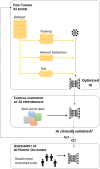A framework for validating AI in precision medicine: considerations from the European ITFoC consortium
- PMID: 34600518
- PMCID: PMC8487519
- DOI: 10.1186/s12911-021-01634-3
A framework for validating AI in precision medicine: considerations from the European ITFoC consortium
Abstract
Background: Artificial intelligence (AI) has the potential to transform our healthcare systems significantly. New AI technologies based on machine learning approaches should play a key role in clinical decision-making in the future. However, their implementation in health care settings remains limited, mostly due to a lack of robust validation procedures. There is a need to develop reliable assessment frameworks for the clinical validation of AI. We present here an approach for assessing AI for predicting treatment response in triple-negative breast cancer (TNBC), using real-world data and molecular -omics data from clinical data warehouses and biobanks.
Methods: The European "ITFoC (Information Technology for the Future Of Cancer)" consortium designed a framework for the clinical validation of AI technologies for predicting treatment response in oncology.
Results: This framework is based on seven key steps specifying: (1) the intended use of AI, (2) the target population, (3) the timing of AI evaluation, (4) the datasets used for evaluation, (5) the procedures used for ensuring data safety (including data quality, privacy and security), (6) the metrics used for measuring performance, and (7) the procedures used to ensure that the AI is explainable. This framework forms the basis of a validation platform that we are building for the "ITFoC Challenge". This community-wide competition will make it possible to assess and compare AI algorithms for predicting the response to TNBC treatments with external real-world datasets.
Conclusions: The predictive performance and safety of AI technologies must be assessed in a robust, unbiased and transparent manner before their implementation in healthcare settings. We believe that the consideration of the ITFoC consortium will contribute to the safe transfer and implementation of AI in clinical settings, in the context of precision oncology and personalized care.
Keywords: Artificial intelligence; Cancer; Computerized decision support systems; Oncology; Personalized medicine; Precision medicine.
© 2021. The Author(s).
Conflict of interest statement
Hans Lehrach is a member of the board of Alacris Theranostics GmbH. Felix Dreher is an employee of Alacris Theranostics GmbH. Lesley Ogilvie is an employee of Alacris Theranostics GmbH. Bodo Lange is the CEO of Alacris Theranostics GmbH. Christoph Wierling is an employee of Alacris Theranostics GmbH. The other authors have no conflicts of interest to declare.
Figures
References
-
- Gulshan V, Peng L, Coram M, Stumpe MC, Wu D, Narayanaswamy A, et al. Development and validation of a deep learning algorithm for detection of diabetic retinopathy in retinal fundus photographs. JAMA. 2016;316:2402–2410. - PubMed
Publication types
MeSH terms
LinkOut - more resources
Full Text Sources
Medical




